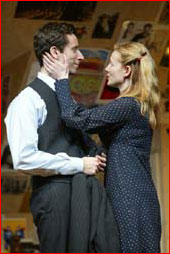
|
||
| Volume III, Issue II | Summer 2004 | |
| Summer 2004 Home Page |
| Culture/ Technology |
| Fiction |
| Music |
| Poetry |
| Theater |
| About / Contact |
| Archive |
| Current Home Page |
'Sight Unseen' plumbs psychology of ambitious painter and the woman he discarded
Past intrudes through surprising, shifting flashbacks that alter the present
By Lucy Komisar
NEW YORK
|
The portrait that Jonathan Waxman (Ben Shenkman) painted of his lover Patricia (Laura Linney) when they were in college in the U.S. 15 years ago hangs in the chilly Norfolk, England, stone farmhouse she now shares with her British husband, Nick (Byron Jennings). The painting is almost a totem, representing a lost love to her and an invisible rival to Nick.
Director Daniel Sullivan emphasizes the play's edge and mystery, so that even the most commonplace events seem to have other meanings. It is an absorbing production. Only an interview with the artist by a German journalist (Ana Reeder) drags.
 Ben Shenkman and Laura Linney Photo by Joan Marcus |
Jonathan arrives after many years because, now famous and rich, he's opening a one-man show in London. And he remembers the painting.
As the former lovers spar, you start taking sides. He dropped her because she was a "shiksa." Point against him. He makes sexually and racially exploitative pictures, including one of a black man atop a white woman in a cemetery – is it rape? Another point lost.
Nick calls Jonathan's art pornography. Corporations are buying this porn art "sight unseen." Jonathan remarks on "the lengths people go to in order to feel something." His face is bereft of personality; he seems to have no conscience. How about him feeling something? Patricia, on the other hand, is suffused with the pain of lost love. Linney gives a rich, complex portrayal of a woman whose soul seems gripped in a failed passion. Jennings is a worthy foil as a man quietly suffering from unrequited love.
The scenes flip back and forth in time, so that just as you think you've made up your mind about who is "guilty" in the failed relationship, you learn some new, earlier facts. Who seduced who, anyway? Is a college romance a commitment for life?
Then, there is the Jewish aspect. Jonathan is Jewish. His cemetery painting is called Walpurgisnacht, Witches' Night, and it's of a Jewish cemetery spray-painted with swastikas. His mother didn't like Patricia because she was a "shiksa," but then he married another one. Patricia refers to herself as "the sacrificial shiksa who laid the groundwork."
Margulies presents a clever aperçu about Jewish artists who are successful but still choose to think of themselves as outsiders – as artists and as Jews – as alienated from mainstream culture. Shenkman is good as the New York neurotic, though he somehow lacks the passion of a man who lets ambition rule his life.
The ideas get a little messy and are never altogether resolved, but sometimes a play's success is in such messiness, in not tying up all the ends, so that – as in this case – you walk out talking about the work, trying to figure both it and the characters out.
![]()
Summer 2004 Theater Section | Summer 2004 Main Page
Current Theater Section | Current Home Page
Copyright ©
Reprinted by permission of author, who retains all copyright and control.